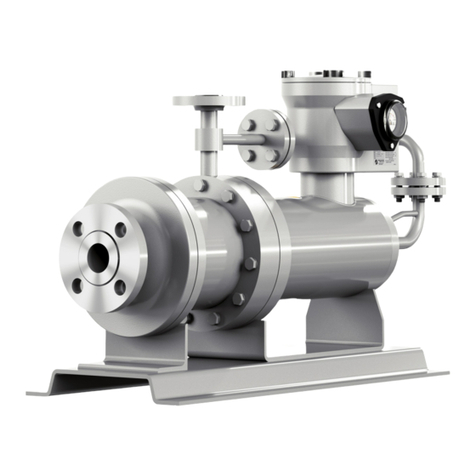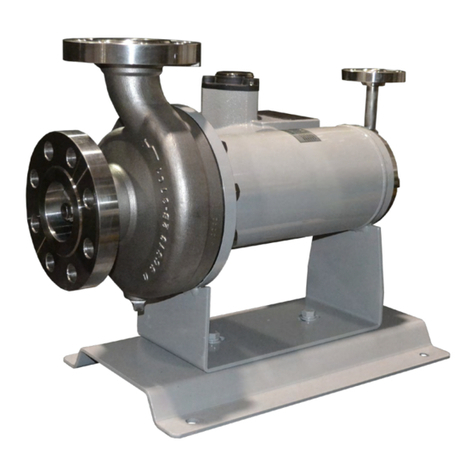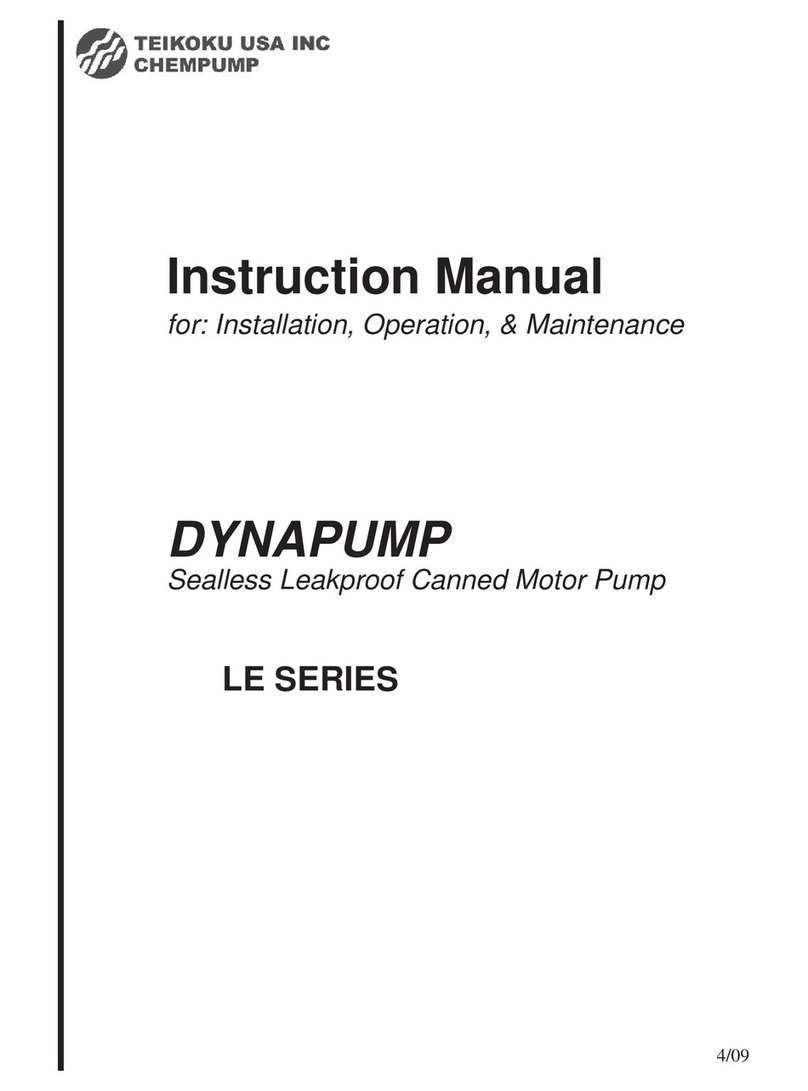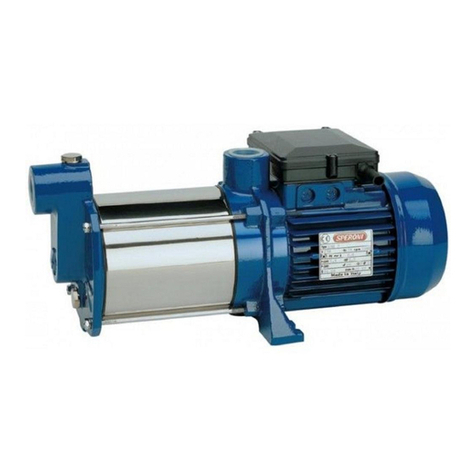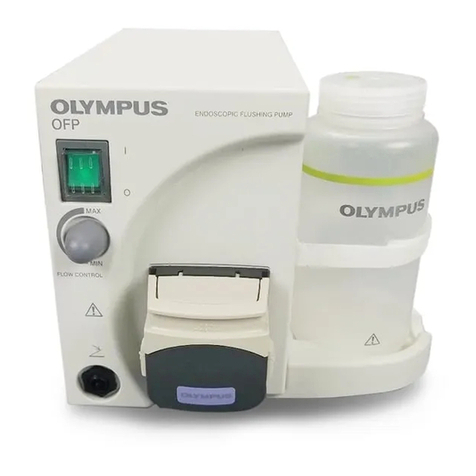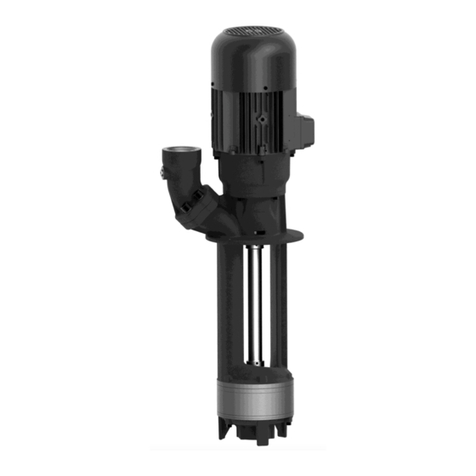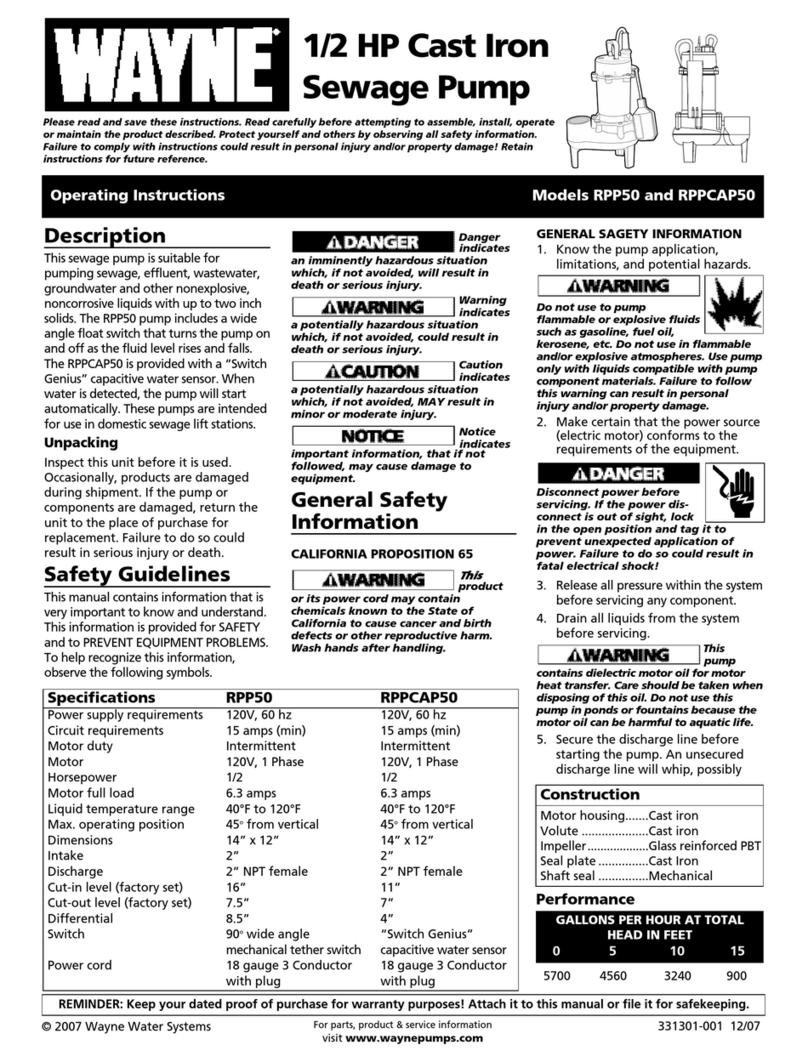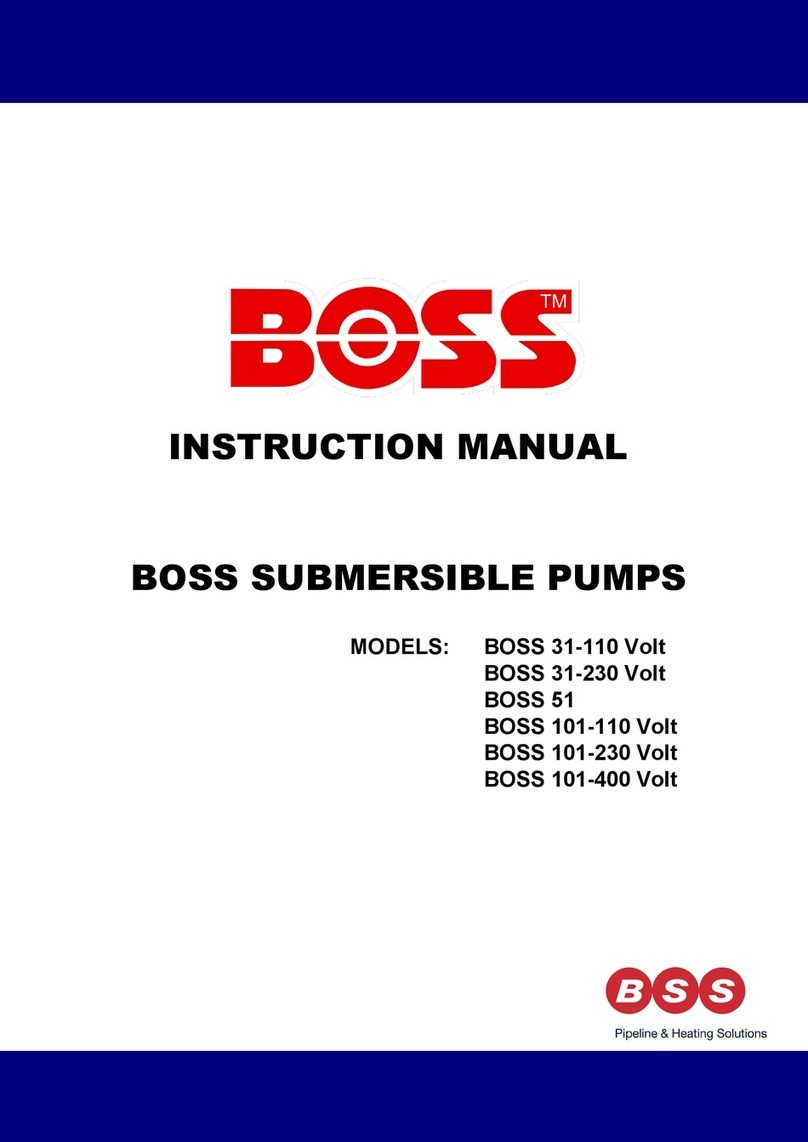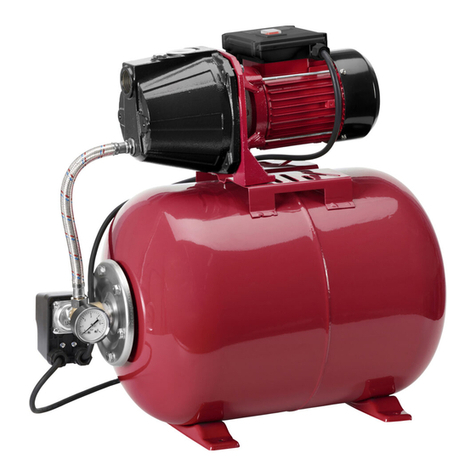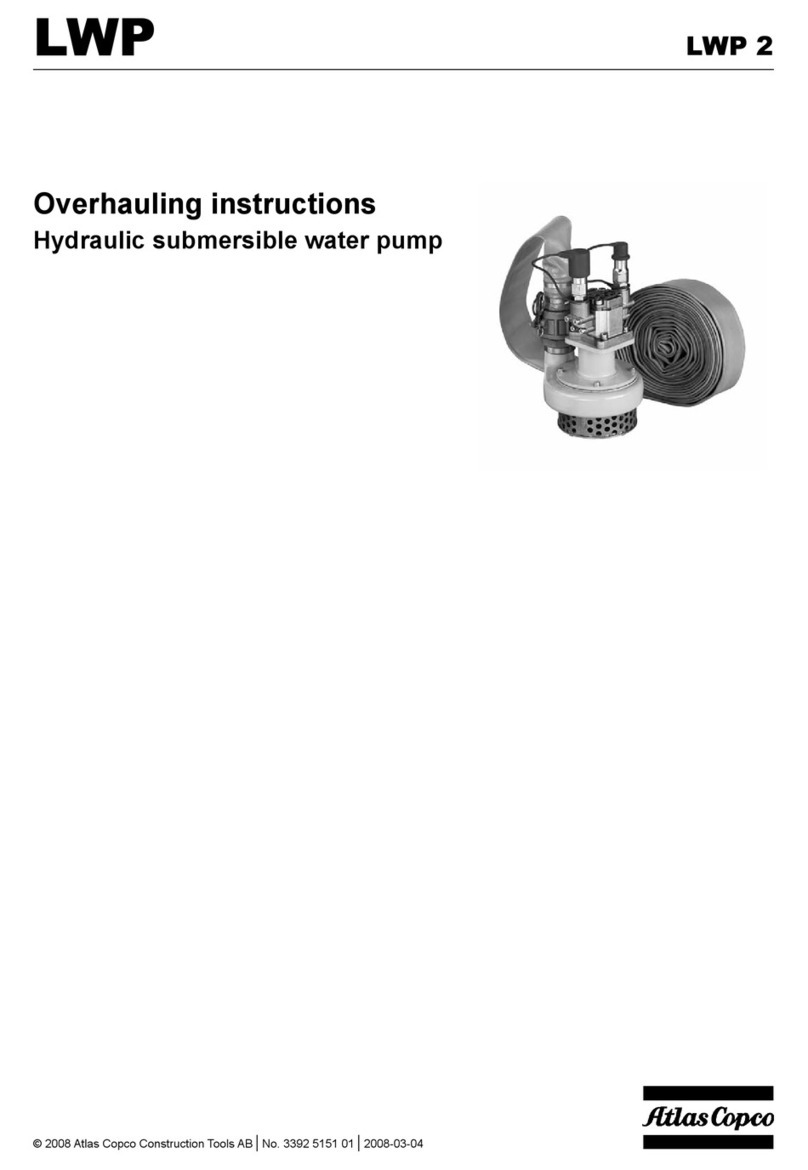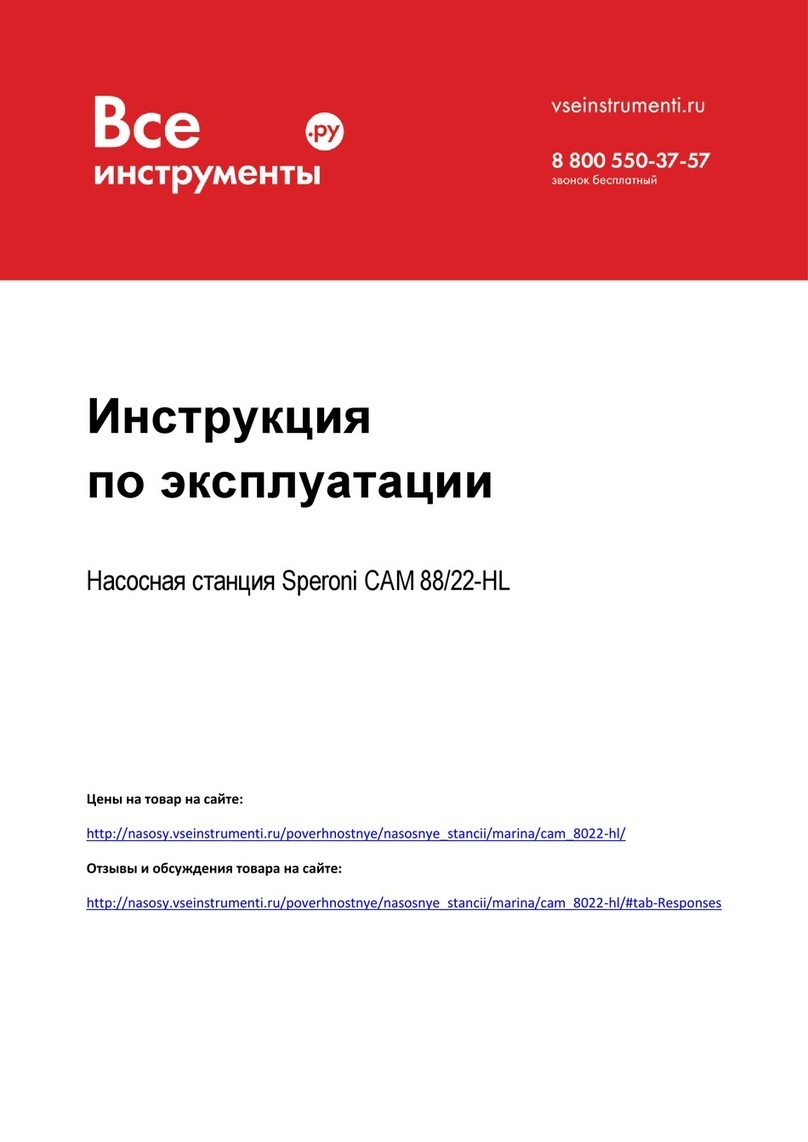Teikoku CHEMPUMP G Series User manual

INSTRUCTION MANUAL
for Installation, Operation, and Maintenance
JUNE 2019
CHEMPUMPTM G-SERIES
Sealless Canned Motor Pump
With Teikoku Rotary Guardian (TRG)

Thank you for purchasing a ChempumpTM G-Series pump.
Please carefully read this instruction manual and all Safety Warnings prior to use.
Introduction
Safety Terms
Please pay close attention to these terms. When you see them
in this manual, read the information thoroughly and follow the
instructions given.
Attention!
Indicates careful attention is required. The instruc-
tion includes protective information for the device and
product.
Caution!
Ignoring this warning can cause personal injury and/or
damage to the device and product.
Hazard!
Ignoring this warning can cause serious injury or even
death. It can also be used to alert against unsafe practices.
NOTE: Information included in NOTES gives additional helpful
information and recommendations.
Applicable Standards and Regulations
The G-Series pump conforms to the following standards:
1. American Society of Mechanical Engineers (ASME) B-16.5
2. Canadian Standards Association (CSA): UL 778 CSA 22.2
No 108
Product Warranty Period
This product is warranted for two years from date of delivery.
Please refer to Teikoku USA’s Terms and Conditions of Sale for
additional warranty coverage and restrictions.
Rights
All rights on products manufactured by Teikoku, corresponding
software, and this instruction manual are registered to Teikoku
Electric Mfg Co., Ltd.
It is not permitted to reproduce or transmit any portion of this
instruction manual unless prior written consent has been ob-
tained from Teikoku USA Inc., Teikoku Electric Mfg Co., Ltd. or
its subsidiaries.
ChempumpTM is a trademark of Teikoku USA INC.
Teikoku Rotary GuardianTM and TRGTM are trademarks of Teikoku
Electric Mfg. Co., Ltd.

Teikoku USA | Chempump Instruction Manual G-Series3
Attention!
Do not run dry!
If the pump is allowed to run dry, the bearings, sleeves,
and other components could be damaged and serious
overheating of the motor windings can occur.
Attention!
Avoid rapid temperature changes!
Large changes in temperature must be avoided. Rapid
changes can cause leaks to occur in gaskets. Published
procedures for proper heating and cooling must be fol-
lowed. If published procedures are not available, check
with Teikoku before operating the equipment.
Caution!
Hot – Do not touch!
Motor and pump can be hot, even when pumping cold
liquids.
Caution!
If motor trips, do not restart before determining the
cause!
Restarting the motor before ascertaining the cause may
result in excessive heat, causing pump or motor failure.
Hazard!
Do not remove internal bolts in terminal box.
If it is necessary to remove the terminal box for any reason,
first loosen the bolts by 2 or 3 turns to check if any internal
pressure or liquid is present. You must take measures if the
possibility exists that the gas or liquid is toxic or hazardous
to personnel or the environment.
Hazard!
Do not remove any bolts on pump, motor, or drain
plugs!
The internal pressure can be higher than the atmosphere.
Ensure that the pump and motor are properly de-pressur-
ized and decontaminated prior to performing any work.
Proper protective measures must be taken if the possibility
exists that the gas or liquid is toxic or hazardous to person-
nel or the environment.
Hazard!
Always assume that there is liquid left in the pump!
There is always the possibility that residual liquid could
remain in the pump and motor in spite of thorough de-
contamination. Pay particular attention to the clearance
between the shaft and the impeller, bearings, sleeves,
bearing housings, internal bolting and gaskets. You must
take adequate precautions to protect personnel and the
environment if the liquid could be considered hazardous.
Safety Warnings
Important:
Before operating the canned motor pump, read these Safety Warnings
and this entire Instruction Manual to avoid improper operation.
It is essential for your safety and to avoid disaster.

Teikoku USA | Chempump Instruction Manual G-Series4
Contents
Introduction 2
Overview 5
1. General Information 6
2. Installation 9
3. Operation 18
4. Maintenance 21
Appendix 28
Appx A. TRC-1 Information Sheet .......................................29
Appx. B. Troubleshooting ....................................................30
Appx. C. Engineering Data Sheet 34E ..................................31
Appx. D. Curve - GA(T) Model .............................................32
Appx. E. Curve - GB(T) Model..............................................33
Appx. F. Curve - GC(T) Model .............................................34
Appx. G. Curve - GVBS(T) Model..........................................35
Appx. H. Curve - GVD(T) Model ...........................................36
Appx. I. Curve - GVE(T) Model............................................37
Appx. J. Curve - GVHS(T) Model .........................................38
Appx. K. Curve - N2S 10, 15, & 20K ....................................39
Appx. L. Curve - N2S 30, 40, & 50K ....................................40
Appx. M. Sectional View GVBS .............................................41
Appx. N. Sectional View GA, GB, GC ...................................42
Appx. O. Sectional View GVD, GVE, GVHS ...........................43
Appx. P. Sectional View N2S ...............................................44
Appx. Q. Terminal Box Assembly ..........................................45
Appx. R. Decontamination Certification
and Flushing Procedure .........................................46
Appx. S. Repair Receipt Policy..............................................49
Tables
Table 2-1. Conditions Indicated on the TRG Meter .................11
Table 2-2. TCO Maximum Coil Currents.................................11
Table 2-3. G-Series Electrical Data..........................................12
Table 2-4. Electrical Wiring Data –
230 Volt, 3 Phase. 60 Hertz ...................................12
Table 2-5. Electrical Wiring Data –
460 Volt, 3 Phase, 60 Hertz ...................................13
Table 2-6. Electrical Wiring Data –
575 Volt, 3 Phase, 60 Hertz ...................................13
Table 2-7. Oil Volume in Stators.............................................14
Table 2-8. Standard Recirculation Flow Rates..........................14
Table 2-9. Circulating Tube Size .............................................14
Table 4-1. Recommended Tools..............................................21
Table 4-2. Bearing Journal Dimensions...................................22
Table 4-3. G-Series End Play...................................................22
Table 4-4. End Play on Thrust Bearing ....................................22
Table 4-5. Disassembly Tools: GA, GB, GC, GVBS ...................23
Table 4-6. Disassembly Tools: GVD, GVE, GVHS,
GG, & GVM ..........................................................23
Table 4-7. Disassembly Tools: GLD..........................................24
Table 4-8. Disassembly Tools: N2S ..........................................25
Table 4-9. Phase to Phase Resistance Values...........................27
Figures
Figure 1-1. G-Series Schematic Diagram ....................................6
Figure 1-2. Discharge Filter Arrangement..................................6
Figure 1-3. Bearings – G-Series Sleeved Type ............................7
Figure 1-4. Thrust Surfaces, Models GA, GB, & GC ...................7
Figure 1-5. Thrust Surfaces, Models GVBS ...............................7
Figure 1-6. Thrust Surfaces, Models GVD, GVE, GVHS ..............7
Figure 1-7. Automatic Thrust Balance, Single Ring ....................8
Figure 1-8. Automatic Thrust Balance, Double Ring ..................8
Figure 2-1. Easy Maintenance Base ........................................10
Figure 2-2. Teikoku TRG Bearing Wear Monitor ......................11
Figure 2-3. Back-Flush System ................................................14
Figure 2-4. Reverse Circulation ...............................................15
Figure 2-5. Pressurized Recirculation.......................................15
Figure 2-6. Back-Flush Installation with Electrical Isolation ......15
Figure 2-7. Jacketed Circulation Tube ....................................16
Figure 2-8. Removable Water Jacket ......................................17
Figure 2-9. Removable Heat Exchanger ..................................17
Figure 3-1. Teikoku Rotary Indicator TRC-1 ............................19
Figure 4-1. Parts ....................................................................25

Teikoku USA | Chempump Instruction Manual G-Series5
Overview
Teikoku USA's ChempumpTM G-Series canned
motor pump has been the workhorse of the North
American sealless pump industry for over 50 years.
G Series pumps feature automatic hydraulic thrust
balance, replaceable thrust surface design, direction
of rotation indication and precision front and rear
bearings.
G-Series are capable of pumping fluids from -400ºF
to 1000ºF and working pressures up to 5000 psi.
As with all Teikoku products, no special tools,
foundations, leveling or alignment are required for
installation.

Teikoku USA | Chempump Instruction Manual G-Series6
1.1 General Design and Operation
The ChempumpTM Plan 11-S G-Series is a combined centrifugal
pump and squirrel cage induction electric motor designed and
produced as a single hermetically-sealed unit. The pump impeller
is an enclosed type and mounted on one end of the rotor shaft,
which extends from the motor section into the pump impeller
casing.
The rotor is hermetically sealed or “canned” with a corrosion
resistant, nonmagnetic, alloy shell to isolate it from contact with
the pumped liquid being circulated through the liquid cooled
motor assembly. The rotating rotor and shaft assembly and its
supporting thin film liquid lubricated bearings, operate immersed
in the circulating liquid, functioning as both a motor coolant and
bearing lubricant.
The motor stator winding is also canned with a corrosion resistant,
non-magnetic, alloy liner, to simultaneously isolate it from the
same circulating liquid. ChempumpTM Plan 11-S G-Series pumps
are characterized by the use of an external circulation pipe to
channel and control a portion of pump discharge flow into the
rotor cavity through the rear bearing housing into the rotor cavity
of the motor to effect motor cooling in this liquid cooled motor
design. Through a combination of flow and pressure control
mechanisms designed into the canned motor pump assembly, the
circulating fluid is driven by pump discharge pressure into the rotor
cavity to assure required motor cooling and the establishment of
the bearing liquid film for rotating element support. The flow
path of a Plan 11-S G-Series pump is shown in Figure 1-1. The
circulating liquid is channeled from the discharge flange to the
motor section through the circulation pipe. The circulating liquid
first lubricates the rear bearing, then passes over the rotor, cooling
the motor, moves forward to lubricate the front bearing and then
exits the motor section through the front bearing housing. The
fluid returns to the high-pressure region of the impeller for joining
the pump discharge flow.
The discharge filter, Figure 1-2, located in the discharge nozzle
of the pump casing, helps to extend motor and bearing life by
keeping the circulating fluid free of damaging particles. Although
this filter is open top and bottom, and is constantly washed by the
discharge flow, certain types of solids are gummy and will adhere
to the fine wire mesh, thus restricting flow to the bearings. If
this type of solid is present, periodic inspection of the filter is
recommended.
The G-Series pump is a precision-built unit that, with proper
care, provides years of trouble-free, leakproof service. This
manual, containing basic instructions for installation, operation
and maintenance of G-Series pumps, is designed to assist you in
maintaining this service.
It is important that the persons responsible for the installation,
operation and maintenance of the pump, read and understand
this manual thoroughly. Trouble-free performance begins with
proper pump selection and application. If the selected pump
does not have the required performance characteristics, or if the
materials of construction are not properly specified for the fluid
being handled, unsatisfactory operation may result. No amount
of maintenance can compensate for this.
If you doubt the pump selection or application, email or call your
Teikoku application representative or the factory for assistance
and advice. Additional copies of this manual are available from
Teikoku field representatives or from the factory.
1.2 Stator Assembly
The stator assembly consists of a set of three-phase windings
connected in a one circuit wye arrangement. Stator laminations
1.General Information
Figure 1-1. G-Series Schematic Diagram, Plan 11-S Standard Circulation Single Stage
Figure 1-2. Discharge Filter Arrangement
CIRCULATION FILTER
COUNTER BORE
CIRCULATION LINE
DISCHARGE

Teikoku USA | Chempump Instruction Manual G-Series7
are of low-silicon grade carbon steel. Laminations and windings
are mounted inside the cylindrical stator band. End bells, welded
to the stator band, close off the ends of the stator assembly. Back
up sleeves are provided to strengthen those areas of the stator
liner not supported by the stator laminations. The stator liner is, in
effect, a cylindrical “can”, placed under the stator bore and welded
to the end bell shrouds to hermetically seal off the windings from
contact with the liquid being pumped. Terminal leads from the
windings are connected to a pressure tight terminal plate isolating
the stator cavity from the customer’s electrical connections in the
Teikoku supplied connection box.
1.3 Rotor Assembly
The rotor assembly is a squirrel cage induction rotor constructed
and machined for use in the G-Series Pump. It consists of a
machined corrosion-resistant shaft, laminated core with aluminum
bars and end rings, two corrosion-resistant end covers, and a
corrosion-resistant can. The shaft is provided with flats or with
an impeller key arrangement at one end, to receive the impeller,
and is threaded at the same end to receive the impeller nut which
retains the impeller, or impellers in the case of two-stage models.
The two rotor end covers are welded to the shaft and also to
the rotor can which surrounds the outside of the rotor, thus
hermetically sealing off the rotor core from contact with the liquid
being pumped.
1.4 Bearings
The bearings for the unit are metal sleeved or sleeveless and have
a molded carbon/graphite insert as standard (other materials are
furnished depending on the application), and are machined with
a special helix groove through the bore to assure adequate fluid
circulation at the journal area. Each bearing is manufactured to
close tolerances for a high degree of concentricity, and is held in
a bearing housing by a retaining screw and lock washer. Bearings
are easily replaced by removing the retaining screw and sliding
the bearing from its housing. See Figure 1-3. Single- stage models
may be provided with two bearings in the motor end, while two-
stage models may be provided with two bearings in the motor
end plus another bearing (idler bearing) in the pump casing for
additional shaft support.
1.5 Thrust Surfaces
All Teikoku models equipped with thrust surfaces provide a
replaceable bearing surface against which axial loads can be
carried during upset conditions. This arrangement provides two
thrust surfaces between the impeller and rotor assembly. These
surfaces prevent metal to metal contact in the event of abnormal
pump operation such as running dry or cavitation.
A) Single Stage Models GA, GB, & GC. See Figure 1-4.
B) Single Stage GVBS. See Figure 1-5.
C) Single Stage Models GVD, GVE, and GVHS. See Figure 1-6.
Figure 1-3. Bearings – G-Series Sleeved Type
Figure 1-4. Thrust Surfaces, Models GA, GB, & GC
Figure 1-5. Thrust Surface Models GVBS
Figure 1-6. Thrust Surfaces, Models GVD, GVE, & GVHS

Teikoku USA | Chempump Instruction Manual G-Series8
1.6 External Cooling Flow (Standard Plan 11-S)
Cooling for stator, rotor, and bearings, as well as bearing
lubrication, is provided by circulation of the pumped fluid. A
small flow circulates through the circulation tube, through the
rear bearing housing, across the rear journal, over and around the
rotor, across the front journal and front bearing housing, through
the eye of the impeller, and returns to the mainstream flow. See
Figure 1-1, Page 6.
1.7 Automatic Thrust Balance
A) Single Stage Models GA, GB, GC, GVBS and GVD.
Based on hydraulic principles, G-Series automatic thrust balance is
generated by the pressure of the internally circulated pumped fluid
flowing into a balance chamber just to the rear of the impeller.
When a change in load tends to change the position of the
impeller away from the balance condition, there is an equalizing
change of hydraulic pressure in the balance chamber which
immediately returns the impeller-rotor assembly to the balanced
position. See Figure 1-7.
B) Single Stage Models GVE, GVHS, GG, and GVM.
Automatic thrust balance on these models operates on the
same principle as noted above except that balance chambers are
provided on the front as well as the rear of the impeller to absorb
the additional axial thrust loading of these larger models. See
Figure 1-8.Figure 1-8. Automatic Thrust Balance, Double Ring
Figure 1-7. Automatic Thrust Balance, Single Ring

Teikoku USA | Chempump Instruction Manual G-Series9
2.Installation
2.1 Receipt Inspection
1. Avoid rough handling during loading, transportation and un-
loading.
2. Visually inspect the shipping container for evidence of dam-
age during shipment.
3. Check unit to see that suction, discharge, and any other con-
nections are covered.
4. Inspect the suction, discharge and any other connections gas-
ket seating surface to be certain that they are clean of foreign
matter and free from nicks, gouges, and scratches.
5. Check phase resistance and megger resistance to ground of
the motor windings. Refer to Table 4-9, page 27.
6. Check all nameplate data against shipping papers.
7. Caution should be observed during handling, so as not to
bend the circulation line.
2.1.1 Storage Note
In situations where a pump is to be stored for a period of time
prior to installation, and where the climate experiences wide
temperature changes and high humidity, the terminal box must
be sealed to prevent moisture from entering the motor winding
area.
2.2 Structural
The pump design and construction eliminates the need to align
the pump and motor. The pump should be supported using the
mountings provided and mounted so that its weight is properly
supported. Suction and discharge piping must be properly
supported and aligned so that no strain is placed on the pump
casing.
1. Remove burrs and sharp edges from flanges when making
up joints.
2. When connecting flanged joints, be sure inside diameters
match within 1/16" so as not to impose a strain on the pump
casing.
3. Use pipe hangers or supports at intervals as necessary.
2.2.1 Pump Location
Locate the pump as close as possible to the fluid supply with a
positive suction head. Installations with suction lift are possible
but not recommended.
Since standard pumps are not self-priming, provide for initial
priming and for maintaining a primed condition. Location of the
pump and arrangement of the system should be such that suf-
ficient NPSH (Net Positive Suction Head) is provided over vapor
pressure of the fluid at the pump inlet. NPSH requirements at the
design point are stated on the pump order copy. For additional
design points, refer to the corresponding performance curves
placed in the Appendix of this manual.
Note: Experience has proven that most pump troubles result from
poor suction conditions including insufficient NPSH. The suction
line must have as few pressure drops as possible and available
NPSH MUST be greater than required NPSH.
Depending on job conditions, available NPSH can sometimes be
increased to meet the NPSH required by the pump for satisfactory
operation. NPSH can be tailored by changes in the piping, in
liquid supply level, and by several other methods. Refer to Appx.
B. Troubleshooting.
2.2.2 Mounting and Alignment
Canned motor pumps combine a pump and motor in a single
hermetically sealed unit. No tedious coupling alignment is required
as the pump has no external coupling between pump and motor.
All models can be mounted in any position except the two-stage
Model GLD, which must be mounted with suction and discharge
“up” unless otherwise allowed. For mounting with suction and
discharge on the side or in any other position, modifications must
be made to the standard internal venting arrangement.
Standard ChempumpTM Models GA, GB, GC and GVBS can be
pipeline mounted. However, bases are offered on all models. You
merely have to set the pumps on a foundation strong enough to
support their weight. There is no need to bolt down or grout any
canned motor pump.
Be sure that suction and discharge piping are properly aligned so
that no strain is placed on the pump casing by out-of-line piping.
All G-Series models are provided with a specially made base
designed to facilitate inspection and repair. See Figure 2-1.
2.2.3 Piping Data
Observe the standards of the Hydraulic Institute when sizing and
making up suction and discharge piping. For Reverse Circulation,
Pressurized Circulation, and Back-Flush installations, refer to
Figure 2-4, 2-5, and 2-6. Follow these procedures below for all
installations:
1. Remove burrs and sharp edges when making up joints.
2. When using flanged joints, be sure inside diameters match
properly. When gasketing flanged joints, do not cut flow hole
smaller than flange opening.
3. Use pipe hangers or supports at necessary intervals.
4. Provide for pipe expansion when required by liquid tempera-
ture.
5. When welding joints, avoid possibility of welding shot entering
the suction or discharge line, and thereby entering the pump.
Caution!
Do not weld pipe when it is connected to pump.
6. Do not spring piping when making up any connections.

Teikoku USA | Chempump Instruction Manual G-Series10
7. Make suction piping as straight as possible, avoiding unneces-
sary elbows. Where necessary, use 45-degree or long-sweep
90-degree fittings.
8. Make suction piping short, direct, and never smaller in diam-
eter than suction opening of pump. Suction piping should
be equal to or larger than pump suction port, depending on
pipe length.
9. Ensure that all joints in suction piping are airtight.
10. When installing valves and other fittings, position them to
avoid formation of air pockets.
11. Permanently mounted suction filters are not recommended.
It is extremely important to size and layout the suction system to
minimize pressure losses and to be sure that the pump will not be
“starved” for fluid during operation. NPSH problems are a result
of improper suction systems.
If suction pipe length is short, pipe diameter can be the same size
as the pump suction port diameter. If suction piping is long, the
size should be one or two sizes larger than pump suction port,
depending on piping length.
Use the largest pipe size practical on suction piping and keep pip-
ing short and free from elbows, tees or other sources of pressure
drops. If elbows or tees must be used, locate them from 10 to 15
pipe diameters upstream from suction. When reducing to pump
suction port diameter, use eccentric reducers with eccentric side
down to avoid air pockets.
When operating under conditions where pump prime can be
lost during off cycles, a foot valve should be provided in the suc-
tion line to avoid the necessity of priming each time the pump is
started. This valve should be of the flapper type rather than the
multiple spring type and of ample size to avoid undue friction in
the suction line.
When foot valves are used, or when there are other possibilities of
fluid hammer, it is important to close the discharge valve before
shutting down the pump.
When necessary to connect two or more pumps to the same suc-
tion line, provide gate valves so that any pump can be isolated
from the line. Install gate valves with stems horizontal to avoid air
pockets. Globe valves should be avoided, particularly where NPSH
is critical. If discharge pipe length is normal, pipe diameter can be
the same size as the pump discharge port diameter. If discharge
piping is of considerable length, use larger diameter pipe (one or
two sizes larger).
If the pump is to discharge into a closed system or an elevated
tank, place a gate valve or check valve in the discharge line close
to the pump. The pump can then be opened for inspection with-
out fluid loss or damage to the immediate area.
NOTE: Install properly sized pressure gauges in suction and dis-
charge lines between the pump and the first block and/or check
valve so that operation of the pump and system can be easily
observed. Should cavitation, vapor lock, or unstable operation oc-
cur, widely fluctuating discharge pressures will be observed. Such
gauges provide a positive means of determining actual system
conditions and can be used to great advantage in evaluating sys-
tem problems.
2.3 Electrical and Instrumentation
2.3.1 TRG Bearing Wear Monitor
The TRG is an electrical meter that continuously monitors the con-
dition of the bearings. The TRG is mounted on the electrical junc-
tion box as standard.
The TRG meter operates on the principle of induced voltage.
There are two TRG coils located inside the stator 180° apart. A
magnetic field is created in the stator by current flowing through
the stator windings. In addition, a magnetic field is created by
induced currents in the rotor. When the rotor is perfectly centered
in the stator, the two magnetic fields are essentially balanced.
When bearing wear occurs and the gap between the rotor and
stator decreases, an imbalance in the magnetic fields causes a dif-
ferential induced voltage in the TRG coils. This differential voltage
is indicated on the TRG voltmeter.
The initial display of the TRG meter is adjusted in the factory, but
each meter will show subtle differences. To check bearing wear
Figure 2-1. Easy Maintenance Base

Teikoku USA | Chempump Instruction Manual G-Series11
Figure 2-2. Teikoku TRG Bearing Wear Monitor
Table 2-1. Conditions Indicated on the TRG Meter
The TRG meter has a colored scale which is divided into three zones: Green (0 to 0.5), Yellow (0.5 to 0.75), Red (0.75 to 1)
AT TRIAL OPERATION DURING OPERATION
Indication Condition Solution Indication Diagnosis User Actions
Full scale incorrect wiring change power cable
connection Green Good No action
Yellow to Red phase failure check connection of
cables
Yellow or scale increase of
> 0.3 from initial indication
Bearings worn to
caution level
Plan routine
maintenance
Green normal connection is correct Red or scale increased of
> 0.5 from initial indication
Immediate
maintenance required
Shutdown immediately
and replace worn parts
Hazard! Do not operate if TRG meter condition is RED.
using the TRG meter, use the color change (Green, Yellow, Red)
as a reference. If the increase of TRG readings is 0.3 or more, stop
the pump and check bearings.
The Teikoku Rotary Guardian (TRG) signal is affected by motor
load. Changes in operating frequency or hydraulic load may in-
crease or decrease signal.
Keeping records of the TRG meter reading in conjunction with
motor amp readings will provide a good indication of when the
pump will require maintenance.
2.3.2 Thermal Cutout
Unless otherwise specified, all G-Series pumps are fitted with
thermal cutouts. The cutout is a heat-sensitive bimetallic switch,
mounted in intimate contact with the stator windings. It is to be
wired in series with the holding coil in the starter box. Refer to
Table 2-2 for TCO maximum holding coil currents.
Table 2-2. TCO Maximum Coil Currents
115 Volt 3.1 Amps
230 Volt 1.6 Amps
460 Volt 0.8 Amps
Caution!
The thermal cutout switch does not provide protection
against fast heat buildup resulting from locked rotor con-
ditions, single phasing, or heavy overloads. This protection
must be provided for by the current overload relay heaters
in the magnetic starter. The rating of the heaters should
be high enough to avoid nuisance cut outs under running
loads, but must not be oversized. Refer to Table 2-3 for
starting and running electrical characteristics. It is recom-
mended that “quick trip”, class 10 or less, type heaters
be used.
2.3.3 Starting Equipment
Motor starters (normally not supplied with G-Series pumps)
should be sized to handle the load required per the National Elec-
trical Code (NEC). Start KVA, Full Load KW, Full Load amps and
Full Load KVA data are listed in Table 2-3.
Thermal overload protective devices in the starters should be sized
for the amperage shown on the product nameplate. DO NOT size
the thermal overload protective device in excess of 10% of full
load amp rating. In order to provide complete protection for G-
Series motors under all conditions, it is recommended that “quick
trip” (Class 10) type thermal overload protective devices be used
in the starters where available. Standard type thermal overload
protective devices can be used if these “quick trip” type thermal
overload protective devices are not available. Standard thermal
overload protective devices provide adequate protection for G-
Series motors under starting or normal running conditions, but
require a greater length of time than “quick trip” type thermal
overload protective devices to cut out. This may not protect the
meter if the motor is subject to locked rotor or overload condi-
tions. Also, see Tables 2-3, 2-4, 2-5, or 2-6 for additional electrical
wiring data for the most common G-Series motor sizes to assist in
the electrical installation of the unit.
2.3.4 Variable Frequency Drive (VFD) Power Supply
G-Series pumps can be operated with a VFD power supply. The
VFD should be a Pulse Width Modulated Drive selected for the
appropriate voltage class of the motor, i.e. 400V class for 460V
motors, and suitable to handle the full load current of the motor.
The VFD should always be sized based on full load nameplate

Teikoku USA | Chempump Instruction Manual G-Series12
Table 2-4. Electrical Wiring Data for 230 Volt, 3 Phase, 60 Hz G-Series Pumps
G-Series
Model
Motor
Size
Full
Load
Speed
(rpm)
Switch
Size
Amps
Breaker
Size
Amps
Starter
NEMA
Size
Conductor
Suze for
Motor
Leads
Conduit
Size for
Motor
Leads
Only
Conduit
Size for
Motor
PB & TRG
Leads
Fuse
Size
Code &
Current
Limiting
Amps
Fuse
Size
Dual
Element
Amps
Max
Setting
of Time
Limit
Overload
Protection
Amps
GA
GA, GB, GC
GB, GC, GV, BS, GLD
GB, GC, GV, BS, GLD
1K 3450 30 15 014 1/2 3/4 15 75.3
1-1/2K 3450 30 20 014 1/2 3/4 25 12 8.9
3K 3450 60 (30) 40 112 1/2 3/4 45 20 15.4
5K 3450 60 (30) 50 110 3/4 150 25 20.2
GVD, GVE, GVHS, GG
GVD, GVE, GVHS, GG
GVD, GVE, GVHS, GG, N2S
GVD, GVE, GVHS, GG, N2S
GVD, GVE, GVHS, GG, N2S
5K 3450 100 (60) 70 210 3/4 180 40 28.5
7-1/2K 3450 100 (60) 100 2 6 1 1-1/4 90 45 36.3
10K 3450 200 (100) 125 3 6 1 1-1/4 125 70 50.6
15K 3450 200 (100) 150 3 4 1-1/2 1-1/4 175 80 63.9
20K 3450 200 (150) 200 3 2 1-1/2 1-1/2 200 100 89.29
GVM (1150 rpm) 5P 1150 60 (30) 40 112 1/2 3/4 50 25 20.3
GVM (1750 rpm)
7-1/2L 1750 100 (60) 70 1 8 3/4 190 45 31.05
10L 1750 100 (60) 100 1 8 3/4 1100 50 38.41
15L 1750 200 (60) 125 2 6 1 1-1/4 125 60 47.38
N2S
30K 3450 200 200 41/0 1-1/2 2250 175 112.7
40K 3450 200 200 43/0 1-1/2 2200 200 143.8
50K 3450 400 250 54/0 22-1/2 250 250 174.8
Table 2-3. G-Series Electrical Data
G-Series
Model
Motor
Size
Start
KVA
Full Load Ratings
KVA KW
Amperes
230V 460V 575V
GA
GA, GB, GC
GB, GC, GVBS, GLD
GB, GC, GVBS, GLD
1K
1-1/2K
3K
5K
5.1
10.4
20.8
28.4
1.9
3.1
5.3
7.0
1.5
2.5
4.4
5.9
4.6
7.7
13.4
17.6
2.3
3.8
6.7
8.8
1.8
3.1
5.4
7.0
GVD, GVE, GVHS, GG
GVD, GVE, GVHS, GG
GVD, GVE, GVHS, GG, N2S
GVD, GVE, GVHS, GG, N2S
GVD, GVE, GVHS, GG, N2S
5K
7-1/2K
10K
15K
20K
34.6
52.0
69.2
104.3
138.8
9.9
12.5
17.5
22.2
30.8
8.5
11.0
15.5
20.0
27.0
24.8
31.6
44.0
55.6
77.6
12.4
15.8
22.0
27.8
38.8
9.9
12.6
17.6
22.2
30.9
GVM (1150 rpm) 5P 25.0 7.15 5.0 17.7 8.8 7.1
GVM (1750 rpm)
7-1/2L
10L
15L
38.5
48.5
62.7
10.7
13.1
16.5
7.5
10.0
13.5
27.0
33.4
41.2
13.5
16.7
20.6
10.8
13.4
16.5
N2S
30K
40K
50K
134.0
156.5
188.0
37.4
47.6
57.8
33.0
42.0
51.0
98.0
125.0
152.0
49.0
62.0
76.0
40.0
50.0
60.0
current and not the listed horse power (hp). Sizing based on hp
could lead to an undersized drive being selected. The drive should
be programmed to ensure a linear relationship between voltage
to frequency (V/F) and frequencies should be limited to the range
of 25-65 Hz. Operation at 65 Hz assumes the motor will not oper-
ate in an overload condition. For frequencies beyond these limits
please consult Teikoku Application and Engineering personnel.

Teikoku USA | Chempump Instruction Manual G-Series13
Table 2-6. Electrical Wiring Data for 575 Volt, 3 Phase, 60 Hz G-Series Pumps
G-Series
Model
Motor
Size
Full
Load
Speed
(rpm)
Switch
Size
Amps
Breaker
Size
Amps
Starter
NEMA
Size
Conductor
Suze for
Motor
Leads
Conduit
Size for
Motor
Leads
Only
Conduit
Size for
Motor
PB & TRG
Leads
Fuse
Size
Code &
Current
Limiting
Amps
Fuse
Size
Dual
Element
Amps
Max
Setting
of Time
Limit
Overload
Protection
Amps
GA
GA, GB, GC
GB, GC, GV, BS, GLD
GB, GC, GV, BS, GLD
1K 3450 30 15 014 1/2 3/4 15 32.2
1-1/2K 3450 30 15 014 1/2 3/4 15 73.6
3K 3450 30 20 114 1/2 3/4 20 15 6.2
5K 3450 30 (15) 20 114 1/2 3/4 25 12 8.1
GVD, GVE, GVHS, GG
GVD, GVE, GVHS, GG
GVD, GVE, GVHS, GG, N2S
GVD, GVE, GVHS, GG, N2S
GVD, GVE, GVHS, GG, N2S
5K 3450 30 30 212 1/2 3/4 30 15 11.5
7-1/2K 3450 60 (30) 40 212 1/2 3/4 40 20 15.4
10K 3450 100 50 310 3/4 160 35 20.3
15K 3450 100 (60) 70 3 6 1 1-1/4 80 40 25.6
20K 3450 200 (100) 100 3 6 1 1-1/4 90 45 35.8
GVM (1150 rpm) 5P 1150 30 20 112 1/2 3/4 25 15 8.2
GVM (1750 rpm)
7-1/2L 1750 30 30 112 1/2 3/4 30 15 8.2
10L 1750 60 (30) 40 112 1/2 3/4 45 20 15.4
15L 1750 60 (30) 50 210 3/4 160 30 20.2
N2S
30K 3450 60 80 3 6 1 1-1/4 100 70 46.0
40K 3450 100 80 3 4 1 1-1/4 80 80 57.5
50K 3450 100 90 3 4 1 1-1/4 90 90 69.0
Table 2-5. Electrical Wiring Data for 460 Volt, 3 Phase, 60 Hz G-Series Pumps
G-Series
Model
Motor
Size
Full
Load
Speed
(rpm)
Switch
Size
Amps
Breaker
Size
Amps
Starter
NEMA
Size
Conductor
Suze for
Motor
Leads
Conduit
Size for
Motor
Leads
Only
Conduit
Size for
Motor
PB & TRG
Leads
Fuse
Size
Code &
Current
Limiting
Amps
Fuse
Size
Dual
Element
Amps
Max
Setting
of Time
Limit
Overload
Protection
Amps
GA
GA, GB, GC
GB, GC, GV, BS, GLD
GB, GC, GV, BS, GLD
1K 3450 30 15 014 1/2 3/4 15 3-1/2 2.75
1-1/2K 3450 30 15 014 1/2 3/4 15 74.45
3K 3450 30 15 114 1/2 3/4 20 10 7.7
5K 3450 30 (15) 20 114 1/2 3/4 30 15 10.1
GVD, GVE, GVHS, GG
GVD, GVE, GVHS, GG
GVD, GVE, GVHS, GG, N2S
GVD, GVE, GVHS, GG, N2S
GVD, GVE, GVHS, GG, N2S
5K 3450 60 (30) 40 112 1/2 3/4 40 20 14.3
7-1/2K 3450 60 (30) 40 210 3/4 150 25 19.2
10K 3450 100 (60) 60 210 3/4 170 35 25.3
15K 3450 100 (60) 70 3 6 1 1-1/4 80 40 32.0
20K 3450 200 (100) 100 3 6 1 1-1/4 125 60 44.7
GVM (1150 rpm) 5P 1150 30 30 112 1/2 3/4 30 15 10.2
GVM (1750 rpm)
7-1/2L 1750 60 (30) 40 112 3/4 145 25 15.6
10L 1750 60 (30) 50 110 3/4 160 30 19.2
15L 1750 60 (30) 50 210 3/4 160 30 23.7
N2S
30K 3450 100 100 3 4 1 1-1/4 125 90 56.5
40K 3450 100 100 3 2 1 1-1/4 100 100 71.3
50K 3450 200 125 3 2 1 1-1/4 125 125 87.4

Teikoku USA | Chempump Instruction Manual G-Series14
2.3.5 Oil Filled Stator
G-Series pumps are designed to provide long, trouble free service
with oil filled stator cavities provided as standard. Solid filled or
dry stator options are available for many applications. In order to
facilitate even dissipation of heat from the motor section, elimi-
nate operating hot spots on the motor winding and promote lon-
ger motor life, the stator cavity on standard G-Series pumps is
factory filled with a heat conductive dielectric oil. Inert oils are also
available. Oil filling provides enhanced conductivity and allows the
heat generated in the motor to be conducted to the outside of
the unit, thereby maintaining a lower temperature in the motor
section than would be possible with a dry stator. When storing or
installing oil filled stators, be sure that the motor lead or connec-
tion box nipple is maintained in an upright vertical position. Refer
to Table 2-7 for oil volume in G Series stators.
2.4 Special Conditions and Features
2.4.1 Back-Flushing (Plan 32-S)
For normal, clean fluid applications, G-Series pumps are cooled
and lubricated by the fluid being pumped (Plan 11-S). For slurry
and other “dirty” applications, a system of back-flushing is rec-
ommended.
Back-flushing is noted on the order when recommended. See Fig-
ure 2-3 for a typical back flush installation.
Pumps to be used with back-flush are normally supplied without
circulating tubes. Clean fluid is brought to the fitting at the rear
bearing housing using the customer’s piping as shown in Figure
2-3. The amount of clean base fluid introduced in this manner
should approximate the standard flow rates listed in Table 2-8,
below.
Table 2-7. Oil Volume in G-Series Stators
G-Series
Model
Motor
Size
Volume of Oil
(Fluid Ounces)
GA
GA, GB, GC
GB, GC, GVBS, GLD
GB, GC, GVBS, GLD
1K 41.5
1-1/2K 42
3K 44
5K 45
GVD, GVE, GVHS, GG
GVD, GVE, GVHS, GG
GVD, GVE, GVHS, GG, N2S
GVD, GVE, GVHS, GG, N2S
GVD, GVE, GVHS, GG, N2S
5K 90
7-1/2K 90.5
10K 91
15K 92
20K 93
GVM
5P, 7-1/2L 95
10L 95
15 95
N2S
30K 130
40K 130
50K 130
Table 2-8. Standard Recirculation Flow Rates
Model
Recirculation
Flow Rate
(gpm)
GA
GB
GC
GVBS
1 to 2
1-1/2 to 2-1/2
1-1/2 to 2-1/2
1-1/2 to 2-1/2
GVD, GVE, GVHS
GG
2 to 4
1-1/2 to 3
GVM
GLD
1 to 3
4 to 5
Back-flush pressure should be suction pressure plus 20-30% of
the pressure developed by the pump itself for single stage Models
GA, GB, GC, GVBS, GVD, GVE, GVHS, GG and GVM, and suction
pressure plus 60-80% of the pressure developed by the pump
itself for two stage Model GLD. Excessive back-flush pressure will
destroy the thrust balanced operation built into G-Series pumps
by causing excessive forward thrust.
Procedure:
1. Remove the circulation tube and plug the port in the discharge
neck of the pump casing used for the circulating tube front fit-
ting. (This is done at the factory).
2. Pipe in the clean liquid to the port in the rear bearing housing
used for the circulating tube rear fitting. See Table 2-9 below
for proper circulating tube sizes.
3. If the back-flushing liquid is hot, auxiliary cooling methods,
such as water jacketing the stator must be employed. The tem-
perature of the back-flush fluid should not be close to its boil-
ing point and should not exceed 300˚ Fahrenheit.
Table 2-9. Circulating Tube Sizes
Model Tube Size
GA, GB, GC,GVBS, GLD 1/4" O.D. x 0.035 Wall
GVD, GVE, GVHS, GG, GVM, N2S 3/8" O.D. x 0.035 Wall
Figure 2-3. Back-Flush System

Teikoku USA | Chempump Instruction Manual G-Series15
2.4.2 Reverse Circulation (Plan 13-SE)
For normal clean fluid applications, G-Series pumps are cooled
and lubricated by the fluid being pumped; which flows through
the circulating tube; into the rear of the rotor chamber; across
the rear bearing, rotor, and front bearing; and then back into the
main pumped stream through small holes provided in the rear of
the impeller in the suction area. However, when the fluid being
pumped is at or near its boiling point, plus the additional heat
picked up from the motor, combined with the low pressure at the
impeller suction, the recirculated fluid may vaporize. The reverse
circulation method of lubricating the bearings and cooling the
motor should be used. Flow rates should duplicate those shown
in Table 2-8.
With reverse circulation, the rotor chamber will be under dis-
charge pressure, with cooling fluid circulating from the pump
end, through the rotor chamber, out the rear bearing housing,
and back to the vapor space of the suction vessel. Flow through
stator-rotor cavity must be controlled to allow for a good balance
of pressure and temperature without excessive flow, typically
through the use of an orifice. See Figure 2-4, for a typical reverse
circulation installation. When provided, the reverse circulation
modification is noted on the order.
Procedure:
1. Connect tubing or flanged piping (preferably 1/2" tubing at
least) to the circulating tube port in the rear bearing housing.
2. Run the tubing from the connection port fitting in the rear
bearing housing back to the vapor space of the suction re-
ceiver, preferably above the liquid level.
3. Use large size suction line and gate valve for a low pressure
drop and thus improve available NPSH.
2.4.3 Pressurized Circulation (Plan 1-SD)
As an option to reverse circulation when pumping fluids close to
their vapor pressure, pressurized circulation may be used. Fluid
to cool the motor flows from the pump discharge to an auxiliary
impeller (See Figure 2-5) in the back of the pump that adds pres-
sure to the flow through the motor and returns the flow to the
main stream at discharge pressure. With this recirculation system,
the fluid heated by the motor is at sufficient pressure so the heat
added by the motor will not cause the fluid to vaporize.
2.4.4 Electrical Isolation
To eliminate electrolytic corrosion when handling solutions during
an electrolysis or plating operation, the G-Series pump should be
electrically isolated. Insulated couplings or nonconductive plastic
piping must be used in the primary suction and discharge lines.
The pump must be isolated electrically from the tank, and sepa-
rately grounded as shown in Figure 2-6.
Figure 2-4. Reverse Circulation
LOWEST LIQUID LEVEL
HIGHEST LIQUID LEVEL
REVERSE PIPE
BYPASS PIPE
SUCTION
DISCHARGE
QS
QD
QR
QM
HRS
QS
QD
QM
QR
RESTRICTION
ORIFICE
Figure 2-5. Pressurized Circulation
LOWEST LIQUID LEVEL
HIGHEST LIQUID LEVEL
VENT PIPE
SUCTION
DISCHARGE
QS
QD
QV
HRS
QS
QD
QV
Figure 2-6. Back-Flush Installation with Electrical Isolation

Teikoku USA | Chempump Instruction Manual G-Series16
2.4.5 Water and Steam Jackets
When handling fluids at controlled temperatures, additional mo-
tor cooling or heating must be provided. For temperature control,
jackets are provided for water, steam, or other heat transfer me-
dia. In addition, the pump can be submerged into the pumped
fluid, thus providing an additional means of temperature control.
All G-Series pumps can be provided with removable type wa-
ter jackets (See Figure 2-8). This type jacket is easily removable
from the stator band to allow for inspection and replacement.
Removable-type water jacket kits are available from the factory
for provision or already installed in the field when additional sta-
tor cooling is required. These jackets are suitable only for heating
mediums compatible with the gasket and jacket material, with
maximum inlet pressure of 50 psi and with maximum tempera-
ture of 150° F. They should not be used as steam jackets. Jackets
welded to the stator band are available for use as steam jackets
and for liquid mediums which exceed the temperatures and pres-
sures noted above. Normally welded type jackets are suitable for
steam pressures to 50 psi and liquid medium pressures to 100 psi.
However, welded type jackets specially fabricated are also avail-
able for higher pressures.
2.4.6 Heat Exchanger
Similar to the water jacket in every respect except for the pro-
vision of corrosion-resistant tubing, heat exchangers, whether
removable, or welded-on, are provided on Teikoku applications
that require heating or cooling the fluid before it enters the rotor
chamber. Heat exchangers are especially recommended for liquids
with low specific heat characteristics.
All G-Series pumps can be provided with removable wrap around
heat exchangers when specified. This type jacket is easily removed
from the stator band to allow for inspection and replacement.
These heat exchangers are suitable for maximum inlet pressure
of 50 psi and maximum temperature of 150° F. See Figure 2-9.
Welded on heat exchangers are available on all G-Series pumps.
These heat exchangers are suitable for steam pressure of 50 psi
and liquid medium pressures to 100 psi, where maximum temper-
atures vary depending upon existing motor insulation and TCO
setting as indicated on the pump nameplate.
2.4.7 Jacketed Circulation Tube
The jacketed circulation tube acts as a heat exchanger in that it
permits a heat transfer medium to circulate around the tubing
and heat or cool the fluid before it enters the rotor chamber. The
jacketed circulation tube is suitable for maximum inlet pressures
of 50 psi liquid, or 15 psi steam. Higher pressures are available on
special models. See Figure 2-7.
Figure 2-7. Jacketed Circulation Tube

Teikoku USA | Chempump Instruction Manual G-Series17
Figure 2-8. Removable Water Jacket
Figure 2-9. Removable Heat Exchanger

Teikoku USA | Chempump Instruction Manual G-Series18
3.Operation
3.1 Procedure Before Initial Start
Attention!
Before starting the pump for the first time, make sure suc-
tion and discharge piping are free of tools, nuts, bolts, or
other foreign matter. Save time and money by checking
before start-up.
Attention!
It is recommended to install a temporary cone-style strain-
er near the suction port to trap scale and other foreign
particles. Suction strainer to be sized and designed per
Teikoku recommendations. The screen can be installed for
24 hours of operation, but must be monitored closely so
the pump does not become starved for liquid because of a
clogged screen. Remove screen after 24 hours of running.
3.2 Preparation and Trial Operation
The following procedures are recommended for protection of
canned motor pumps in industrial services.
Teikoku USA recommends monitoring the differential pressure
and the power monitor for total protection of the pumps. Teikoku
recommends using both as differential pressure works best for
cavitation protection and the power monitor works best for no
flow, loss of flow and excessive flow. If only one method is going
to be applied then differential pressure would be the preferred
method.
The preferred method for differential pressure monitoring is to
install pressure transducers in the suction line between the pump
and the block valve and in the discharge line between the pump
and the first valve (either check or block). The signals from the
pressure transducers are then sent to the control system and the
pressure and time delay limits can be set within the control system
program. Calibration of the transducers should always be checked
as part of the installation process and startup of the system.
Recommended set points are:
• Differential Pressure (DP): 15 to 20 PSI below normal op-
erating differential pressure
• Time Delay (TD): 20 seconds or less
When using an automatic control system, the following param-
eters are recommended:
A. Single pump:
• 20 Second Delay: Low differential pressure trip
• 60 Second Delay: Pump Restart
Repeat above timing sequence for a maximum of 3 starts. If
low differential continues after 3 starts a manual reset of the
process controller is required.
B. Dual pumps:
• 20 Second Delay: “A” Pump low differential pressure trip
• 60 Second Delay: “B” Pump start
• 20 Second Delay: “B” Pump low differential pressure trip
• 60 Second Delay: “A” Pump start
Repeat above timing sequence for a maximum of 3 starts per
pump (6 starts combined total). If low differential continues
after 3 starts per pump (6 starts combined total) a manual
reset of the process controller is required.
Commercially available differential pressure switches are available
with little to no adjustment. These switches will work but with no
adjustment in the time frame or differential pressure set points
they typically will not meet Teikoku’s pressure and time delay rec-
ommendations.
The preferred method to monitor the input power to the pump
would be to use a power monitor like the Load Controls PMP-25.
The power monitor prevents failures due to loss of prime, no flow
and excessive flow. The performance curve of the pump is used
to set the low power and high power warnings and trip set point.
Actual operating data can be used to make the final adjustments
to the initial set points.
3.2.1 Setting of Thermal Overload Protective Device
Set the thermal overload protective device at the rated current
indicated on the nameplate. It is effective as a protecting device
for canned motors to set the thermal overload protective device
at as low current as possible. When operating current is far lower
than rated current, set the thermal overload protective device just
above the operating current not the rated current. Generally, it is
recommended to set the thermal overload protective device at the
following values:
• Variation of voltage and load is small: operating current
times 1.1
• Variation of voltage and load is big: operating current
times 1.25
Attention!
Do not set the thermal overload protective device at more
than the full load amps (FLA) listed on the name tag.
3.2.2 Priming and Venting
Complete priming should be carried out in the following order:
1. Open suction valve 100%
2. Open discharge valve 100%
3. If applicable: open reverse circulation line valve 100%
4. Open discharge pipe vent valve 100%
5. Open minimum flow valve (if required)
IMPORTANT! NRTL certified per UL 778 & CAN/CSA
C22.2 No. 108-14 for operation between 25 HZ to
65 HZ with Pulse Width Modulated (PWM) Variable
Frequency Drive (VFD) power.

Teikoku USA | Chempump Instruction Manual G-Series19
Caution!
All valves in the reverse circulation line must remain fully
open while the pump is in operation. Verify that the cor-
rect restriction orifice is properly installed in the reverse
circulation line.
3.2.3 Rotation Check
Centrifugal pump impellers must rotate in the proper direction to
deliver rated head and capacity. The impeller must rotate in the
same direction as the arrow cast on the pump casing.
Caution!
Pump and motor must be fully primed, vented, and liquid
full prior to checking direction of rotation.
3.2.3.a Rotation Check using Type-M TRG Meter
AM-45
The Type-M TRG Meter AM-45 is designed to provide a verifica-
tion of direction of rotation. If the TRG Meter immediately pegs
full scale, the direction of rotation is not correct.
1. Verify suction valve is 100% open.
2. Set discharge valve 10% to 20% open.
3. Check that valves in reverse circulation piping are open. Verify
that the correct restriction orifice is installed in the reverse
circulation line.
4. Switch on the pump for 3 to 5 seconds.
If applicable: Check indication of TRG meter. If TRG meter is
pegged full scale red, the pump is rotating in the reverse direc-
tion. See Section 2.3.1 and Table 2-1.
5. If direction of rotation is not correct, swap any two of the
electrical supply leads and repeat rotation check.
6. Once direction of rotation has been verified, stop the pump
and leave it for several minutes.
7. Once you have determined correct rotation, tag correctly
connected main power leads, in accordance with motor lead
markings.
3.2.3.b Rotation Check using Type-L TRG Meter
A45 C
The Type-L TRG Meter A45 C does not provide direction of rota-
tion. The Teikoku TRC-1 hand-held direction of rotation indicator
is available from Teikoku USA. This portable device can be used to
confirm the rotation of any motor.
1. Verify suction valve is 100% open.
2. Set discharge valve 10% to 20% open.
3. If applicable: Check that valves in reverse circulation piping
are open. Verify that the correct restriction orifice is installed
in the reverse circulation line.
4. Switch on the pump for 3 to 5 seconds.
Check indication of TRC-1 hand-held rotation indicator. See Fig-
ure 3-1.
5. If direction of rotation is not correct, swap any two of the
electrical supply leads and repeat rotation check.
6. Once direction of rotation has been verified, stop the pump
and leave it for several minutes.
7. Once you have determined correct rotation, tag correctly
connected main power leads, in accordance with motor lead
markings.
3.2.3.c Rotation Check using Pressure & Amps
1. Open suction valve 100%.
2. Set discharge valve 10% to 20% open.
3. If applicable: Check that valves in reverse circulation piping
are open. Verify that the correct restriction orifice is installed
in the reverse circulation line.
4. Switch on the pump for 3 to 5 seconds.
5. Note the motor amps and the discharge pressure at a pressure
gauge, which should be installed between the pump casing
and discharge valve.
6. Reverse any two of the three power leads and read the amps
and the pressure gauge again. The higher amps and pressure
is the correct direction of rotation.
7. Once direction of rotation has been verified, stop the pump
and leave it for several minutes.
8. Once you have determined correct rotation, tag correctly
connected main power leads, in accordance with motor lead
markings.
Attention!
It is recommended that the unit be run as little as possible
with a closed discharge valve in order to prevent excessive
overheating of the liquid circulating within the unit.
Figure 3-1. Teikoku Rotary Indicator TRC-1

Teikoku USA | Chempump Instruction Manual G-Series20
3.3 Starting Procedure
After priming and checking the direction of rotation, put the
pump in operation as follows:
1. Set the valve in the suction line to 100% open.
2. Set the valve in the discharge line to 20% open.
3. Start the pump. Pump should operate with very low noise and
vibrations. Excessive or abnormal noise or vibrations should
be corrected immediately.
4. Open discharge valve to desired flow position.
5. Care should be taken in process design to assure there can be
no operation at shutoff or deadhead conditions (zero flow).
All canned motor pumps require a minimum flow that assures
adequate motor cooling circulation. Minimum flow values by
model from laboratory tests on water are provided in Appx.
C., Page 31. Minimum flow requirements will very based on
the fluid pumped and its pumping temperatures. Please con-
sult the factory for any application specific guidance on mini-
mum flow that may be required.
Once pump is operational, check the reading of the TRG meter.
Record initial reading for comparison to future readings. See Table
2-1.
6. During any startup sequence, caution must be exercised not
to exceed full load ampere rating indicated on the nameplate.
7. If the unit has not been run for a period of two weeks or
more, the following inspections should precede its operation:
A. Check terminal box for moisture.
B. Upon starting, check for excessive noise, vibration, erratic
speeds or excessive amp draw.
Caution!
The pump should not be allowed to run for more than one
minute with the discharge valve fully closed.
NOTES:
1. If the suction and discharge lines are completely filled with
system fluid and adequate suction head is available the pump
can be started without closing the discharge valve. During any
startup sequence, caution must be exercised not to exceed full
load amperage rating indicated on the nameplate.
2. If the unit has not been run for a period of two weeks or more,
the following inspections shall precede its operation:
a) Check secureness of base hold down bolts if supplied.
b) Check terminal box for moisture and tightness
of fittings.
c) Upon starting, check for excessive noise, vibration, or
erratic speeds.
Caution!
If the pump appears to be airbound as a result of the unit
not being properly primed, do not continue operation. Lo-
cate and correct the conditions that prevent proper prim-
ing before attempting to start the unit.
3.4 Operation Details
TRG Meter should be checked periodically during operation. If
the initial reading (TRG) was not recorded, then the color coding
system shown in Table 2-1 may be used to determine bearing
changing intervals.
Hazard!
Do not operate if TRG meter conditions is RED.
Discharge pressure should be checked frequently during opera-
tion. Pressure should be stable in a non-variable closed loop al-
though the discharge pressure gauge needle may show small
fluctuations. Check motor amps at normal operations. Verify mo-
tor amps are within the expected range. Pump should never be
operating above the rated full load amps listed on the nameplate.
In some cases, the liquid supply may contain an excessive amount
of air or gas, which will tend to separate from the liquid and re-
main in the passages of the pump. This results in the pump losing
its prime and becoming air bound with marked reduction in ca-
pacity. The discharge pressure gauge will show large fluctuations
if this occurs. Stop the pump and vent per Section 3.2.1.
If any abnormal noise or vibration is observed, stop the pump and
check for the possible causes, see Appx B. Troubleshooting.
Table 3-1 Minimum Flow
Model Minimum Flow (GPM)
GA 6
GB 7.5
GC 20
GVBS 20
GVD 25
GVE 45
GVHS 22
GG 65
GKS 55
GK 90
GVM 60
GN 75
GP 75
GS 140
GRS 250
3.5 Shutdown Procedure
Shutdown as follows:
1. Stop the pump (de-energize the motor).
2. If pump is to be removed from service, shut all valves.
Attention!
If the pump is to be shut down for a long period of time
or if there is danger of freezing, after stopping the pump,
shut all valves and drain the entire pump and connected
piping.
This manual suits for next models
20
Table of contents
Other Teikoku Water Pump manuals
Popular Water Pump manuals by other brands
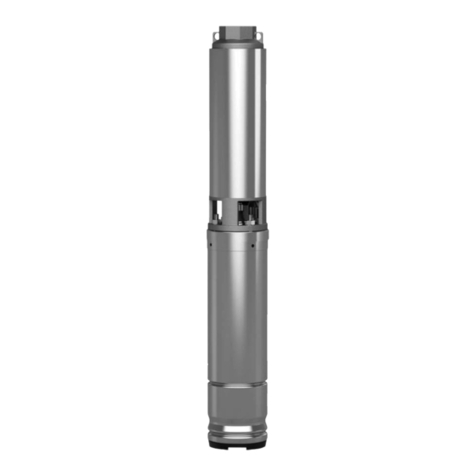
Wilo
Wilo Actun FIRST SPU 4 Installation and operating instructions
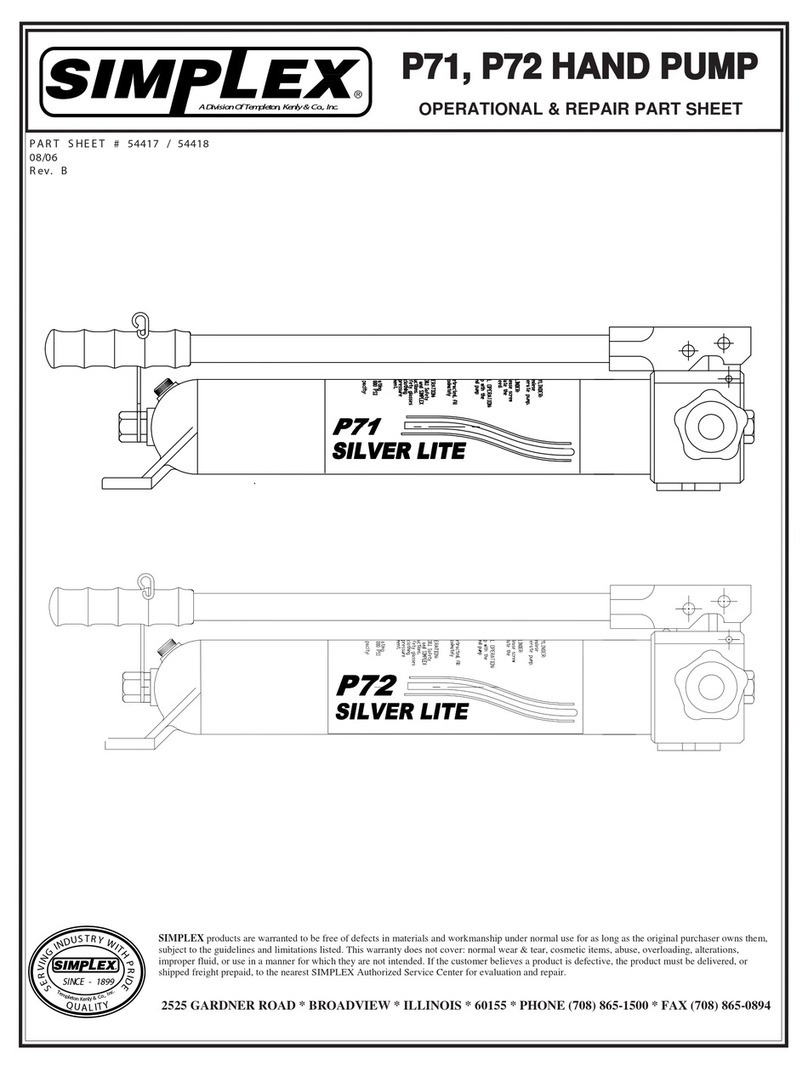
Simplex
Simplex Silver Lite P72 Operational manual
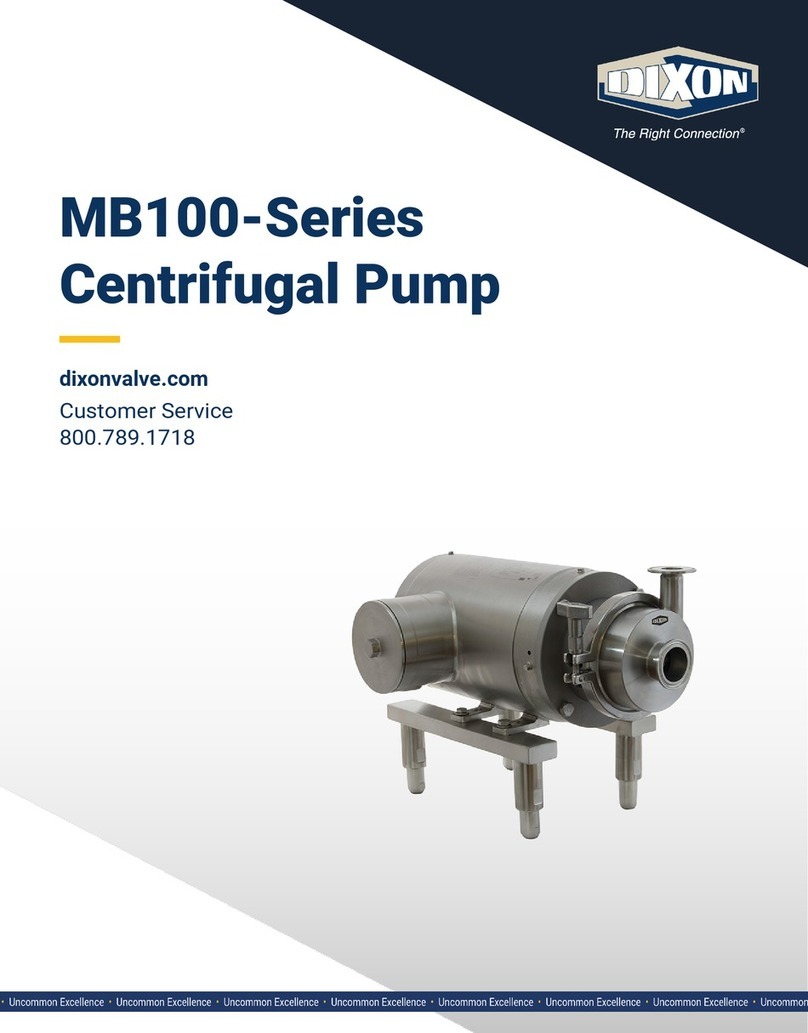
Dixon
Dixon MB100 Series manual

Ashland
Ashland AC-15 OPERATION, PERFORMANCE, SPECIFICATIONS and PARTS MANUAL
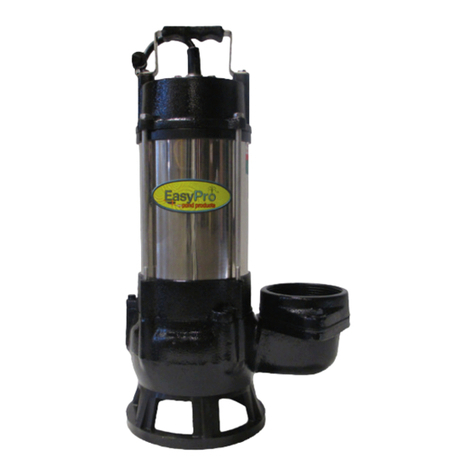
EasyPro
EasyPro TB Series Instructions for operation
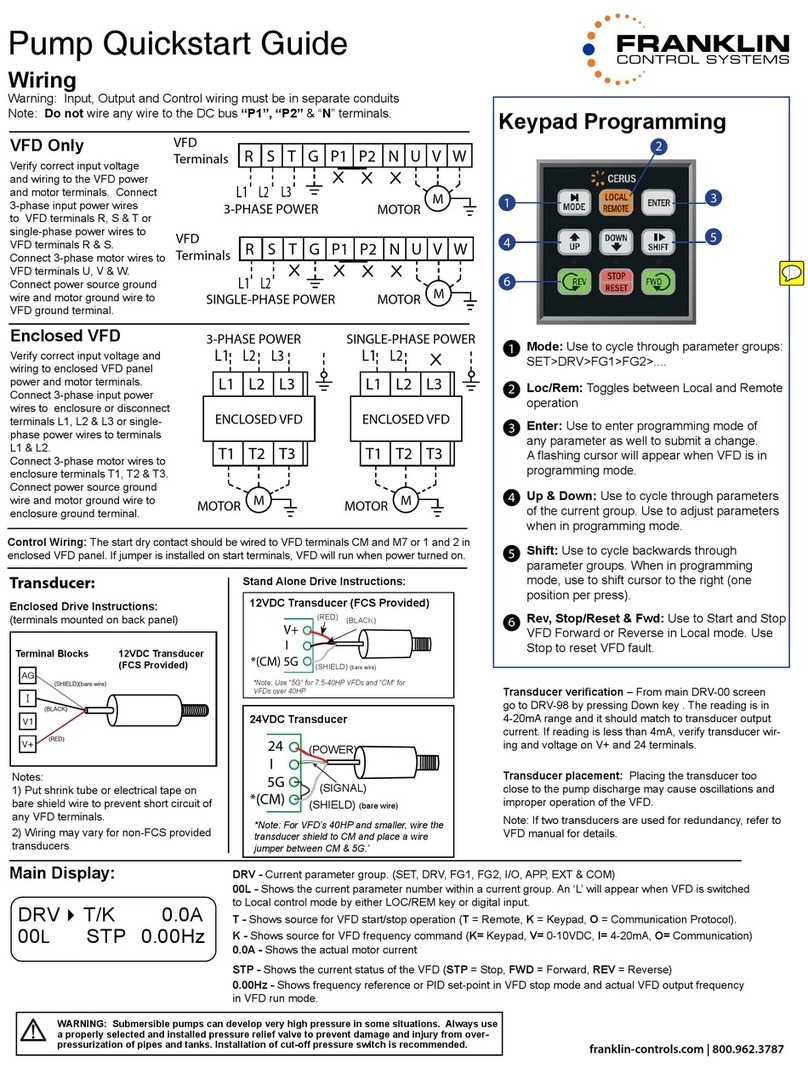
Franklin
Franklin VFD 1 quick start guide
